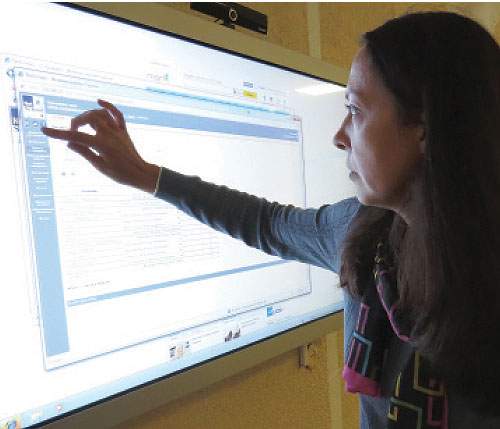
Gadgets help pupils
The Virtual School project — partnered by the Ministry of Education of Belarus and Sberbank of Russia — envisages establishment of a multi-service information-educational environment in an educational establishment. Last May, bankers allocated almost 1.5m Russian Roubles to equip Orsha gymnasium — including buying and installing of a powerful server, interactive software boards (for classrooms where physics, chemistry, mathematics and biology are lectured), a ‘mobile class’ with 25 notebooks, and a large sensor screen which could be used as an e-workbook. Last year’s alumni kindly envied younger pupils, noting, “These children are lucky! We had no such interesting equipment. Studies are more fun with the latter. Moreover, wider opportunities open in learning new knowledge.”
Play and study
A teacher of chemistry, Vladimir Busel, demonstrates me the new possibilities. Among them is an interactive board which looks like an ordinary white canvas from the first sight. In reality, this is a large computer screen; a special sticker (resembling a ‘hybrid’ of an e-pencil and a computer) is sued to write upon it — either in black, or green, or red. The thickness and colour of lines vary depending on the set task. In distinction from a classical board, no chalk or wet cloth are needed. In addition, everything written could be saved in a computer memory. Erasing is possible with a single click (though a rubber could be chosen among instruments to erase a fragment).
Mr. Busel adds that studies are now possible via playing. “The software includes a chemical laboratory,” he explains. “Choosing and mixing chemical ingredients resemble a computer game; while doing so, virtual experiments are possible — i.e. demonstrating how lithium colours a gas-burner flame into violet. It’s a great fun which is, importantly, useful. Actually, this is truly convenient if a school lacks a well equipped laboratory or some rare chemical agents.”

The new equipment makes it possible to conduct a test in a couple of minutes. To do this, pupils take a remote with six buttons. While answering a question (which they see on a board), children need to press the correct button — which greatly resembles a TV quiz. A teacher, in turn, sees test results on their notebook screen.
Homework in blogs
Twenty five notebooks create the local ‘mobile class’. They are kept in an original wheeled trolley, with Wi-Fi connection. When not used, the notebooks are charged and, if necessary, could be moved from one classroom to another. They are distributed among pupils who are proposed to make exercises from their teacher’s Internet blog. As the Deputy Director, Marina Atsetskaya, admits, some teachers are widely using Internet for educational purposes. “Many educational portals exist where teachers can find materials for their classes: diagrams, posters, cartoons and video-clips. They could either compile their own teaching methods. Moreover, the new e-system could be used for the school paperwork and schedule arrangement.”
The schedule appears on a large sensor screen, at the gymnasium hall. Parents — who have access to an individual login and keyword — can learn everything of their children’s progress. This is a kind of an e-diary. Director Natalia Kokhova notes that the screen could be also used for the gymnasium’s own TV news. “The English equipment was installed by Russians in late May of 2014. Our teachers were taught how to manage it. However, I think we’d need to send them for an internship to Minsk Lyceum of the Belarusian State University which is applying the Virtual School for a long time. The information-educational environment is truly in demand but it requires mastery of its use. Importantly, this should be done in a way when teachers learn pupils do with gadgets — rather than vice versa.”
In recent times, information technologies have much advanced, easing teachers’ job. Moreover, they can demonstrate modern pupils and their parents that Internet opportunities stretch farther than e-games or social network connections; successful knowledge mastering is possible. Orsha gymnasium is getting convinced in the latter since September 1st. At the moment, 420 children attend its 5th-11th grades; these school-children already plan to further develop and improve the new Virtual School project. As Ms. Kokhova notes, an e-checkpoint is supposed to open soon at the gymnasium; to implement the idea, additional funds are needed. However, everything is now ready for pupils to take part in virtual Republican (or even international) Olympiads — worthily rivalling their peers from the capital.
By Sergey Golesnik











